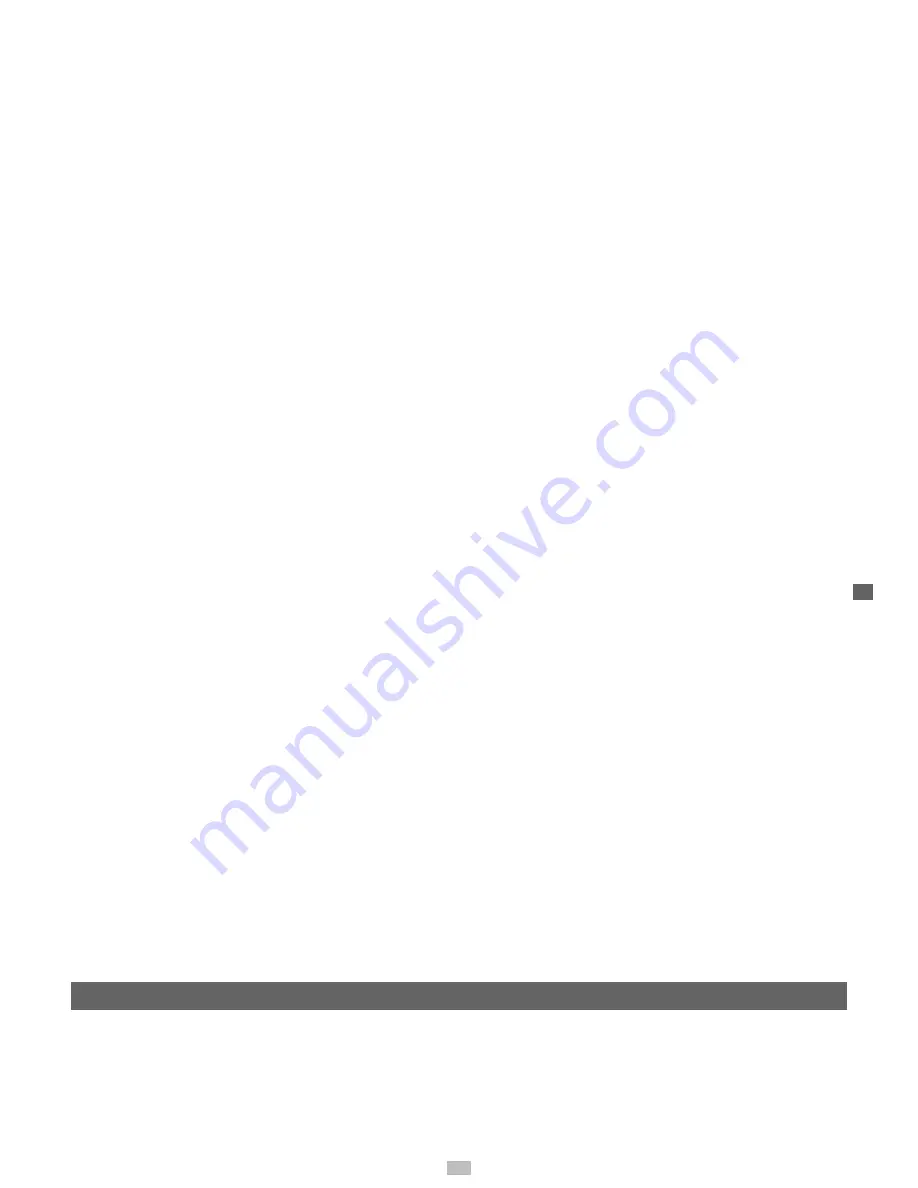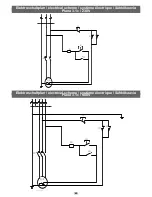
14. Disconnect tools
- When not in use, before servicing, and
when changing accessories such as
blades, bits and cutters.
15. Remove adjusting keys and wrenches
- Form the habit of checking to see that
keys and adjusting wrenches are remo-
ved from tool before turning it on.
16. Avoid unintentional starting
- Don‘t carry plugged-in tool with finger
on switch. Be sure switch is off when
plugging in.
- Never leave a running machine unat-
tended. Before you leave the workplace
switch off the machine.
17. Outdoor use extension cords
- When tool is used outdoors, use only ex-
tension cords intended for use outdoors
and so marked.
18. Stay alert
- Watch what you are doing. Use common
sense. Do not operate tool when you are
tired.
- Do not operate the machine under the
influence of drugs, alcohol or any me
-
dication. Be aware that medication can
change your behaviour
.
19. Check damaged parts
- Before further use of the tool, a guard
or other part that is damaged should be
carefully checked to determine that it will
operate properly and perform its intended
function. Check for alignment of moving
parts, binding of moving parts, breaka-
ge of parts, mounting, and any other
conditions that may affect its operation.
A guard or other part that is damaged
should be properly repaired or replaced
by an authorized service center unless
otherwise indicated elsewhere in this
instructions manual. Have defective swit-
ches replaced by an authorized service
center. Do not use tool if switch does not
turn it on and off.
20. Warning
- The use of any other accessory or
attachment other than recommended it
this operating instruction or the Einhell
catalog may present a risk of personal
injury.
21. Have your tool repared by an expert
- This electric appliance is in accordance
with the relevant safety rules repairing
of electric appliances may be carried out
only by experts otherwise it may cause
considerable danger for the user.
22. Connect the dust extraction devic
Wherever there are facilities for fitting a
dust extraction system, make sure it is
connected and used.
Additional safety instructions
Do not use blunt knives. Risk of kick-back.The
cutter block must be fully covered.
Use a push stick to plane any short workpie-
ces.Take additional safety precautions if you
are planingany narrow workpieces. It may be
necessaryto use lateral pressure equipment
and springloadedcovers to ensure that you
can work insafety.
The machine is not suitable for cutting reba-
tes.The anti-kick safeguard and the infeed
roller mustbe inspected at regular intervals.
Machines fitted with a sawdust extractor
andextractor hoods must be connected to the
devices concerned. The type of material used
can have a negative influence on the dust
generated.
The machine is designed exclusively for the
cutting of wood and similar materials.
The knife must be replaced immediately once
it becomes worn down by 5%.
If a push stick is not used there may be a
risk of serious danger. The push stick should
always be kept at the point provided on the
left-hand side of the machine when not used.
There is a greater risk of danger when small
workpieces are fed in by hand. Always obser-
ve the manufacturerʼs instructions on the use
of the push stick.
If the safety covers, infeed table or mesh are
incorrectly aligned they could lead to uncont-
rollable situations. Damaged or soiled workpi-
eces may cause a risk of danger. Never use
metal parts in the machine or any materials
which can fracture or shatter.
Risk of injury! To cut long workpieces, always
place them on a mobile table or similar type
of supporting equipment. Otherwise there is a
risk that you may lose control over the workpi-
ece. The machine is only suitable for planing
and thicknessing.
Wear suitable protective clothing when wor-
king with the machine.
- ear protection to prevent damage to your
ears,
- a breathing mask to avoid the risk of inhaling
hazardous particles of dust,
- safety gloves to avoid injuries from sharp
edges or knives,
- safety goggles to avoid eye injuries from
flying parts.
It is imperative that the following situations are
avoided at all times: Premature interruption of
the cutting operation (planing cuts which do
not complete
the entire length of the workpiece; planing of
uneven pieces of wood which do not lie flat on
the infeed table). The machine is designed for
private use only. It is prohibited to use the ma-
chine for professional or commercial use. Re-
sidual risk: Bear in mind that there is always
the possibility of residual risks associated with
the use of the machine even if you comply
with all the safety instructions. By complying
with these instructions and taking suitable care
when using
the machine you will reduce the risk of injury
or of damage to the machine. Particular risks:
- Injuries to fingers or hands from parts of
the machine or from workpieces, e.g. when
changing the planing knife
- Risk of electric shock if you use power con-
nections which do not comply with standards
- Contact with conductive parts on opened
electrical components
- Hearing impairments if you work for lengthy
periods without ear protection
- Emission of hazardous sawdust if a dust
extractor is not used. Even if all safety pre-
cautions are complied with it is still possible
for some residual
risks to remain. Important! If the primary mains
connection is in a
poor condition there is a risk of short-circuits
when the machine is switched on. This may
also affect other functions (e.g. the lighting up
of indicator
lamps). Should there be any faults in the
primary mains connection (max. current impe-
dance < 0.105 Ω), please contact your local
electricity supplier to advice and information.
If the blade is fastened and positioned incor-
rectly this may result in the blade being flung
out, which may be a cause of danger. Therefo-
re, before operation, make sure that the blade
is correctly fitted and adjusted in accordance
with the operating
instructions. Every part of the blade shaft not
used for planning must be covered.
Check the machine and carry out required
maintenance work on it each time before you
start it up. In particular, inspect all the anti-kick
claws and the infeed drive shaft.
Make sure that the dust extraction system
and collector are connected and are used
correctly. Make sure that the dust extraction
system is suitable. Fine sawdust may not
only be harmful to health, in certain concen-
trations it can also be potentially explosive.
Always switch off the machine and pull out the
mains plug before making any adjustments or
changing settings. Sawdust may cause risks
to health.
Please keep these safety instructions in a
safe place.
Intended use
m
• The planer has been constructed exclusively
for processing wood using the tools and
accessories on offer. No metal workpieces
my be machined.
• The machine complies with the relevant EC
machine guidelines.
• The machine has been designed for single-
shift operation, duty-cycle S1.
• All safety and hazard notices on the machine
must be observed.
• All safety and hazard notices on the machine
must be kept in a completely legible condi-
tion.
• When the machine is being used in a closed
room, an extraction unit has to be connected.
• Use an extraction unit to remove shavings or
saw dust. The flow rate at the extraction port
must be 20 m/s. Negative pressure 1200 Pa.
• For work in a commercial area, a deduster
has to be used.
Do not switch off or remove extraction units
or dedusters when the machine is running.
• Use the machine in a technically flawless
condition only, as well as for its intended
purpose, in a safe manner and being aware
GB
17
Summary of Contents for plana 3.1c
Page 4: ...1 1 3 4 2 6 5 12 10 8 9 13 7 11 4...
Page 5: ...2 2 5 3 3 1 A B C 3 4 5 2 1 6 2 1 7 5 6 D 8 D 5...
Page 6: ...9 9 1 9 2 10 11 12 12 1 13 12 9 E 8 7 K L M F G 10 11 D 6...
Page 23: ......
Page 25: ......











































